Exploring the Pros and Cons of Vinyl Siding for Your Home
Introduction
Vinyl siding is popular for homeowners seeking an affordable, low-maintenance solution to protect and beautify their homes. While it offers numerous advantages, it’s also essential to consider the potential drawbacks before deciding. In this article, we’ll explore the advantages and disadvantages of having vinyl siding, helping you make an informed choice that aligns with your needs and preferences.
Advantages of Vinyl Siding
1. Low Maintenance:
One of the standout benefits of vinyl siding is its low maintenance requirements. Unlike wood siding, which requires periodic painting, staining, and sealing, vinyl siding only needs occasional cleaning with soap and water to keep it fresh and vibrant.
2. Affordability:
Vinyl siding is often more budget-friendly than other siding materials, such as wood or brick. The lower initial cost and minimal maintenance expenses make vinyl siding an attractive option for homeowners looking to improve their home’s exterior without breaking the bank.
3. Durability:
Vinyl siding is designed to withstand various weather conditions, including rain, snow, and intense sunlight. It doesn’t rot, warp, or corrode like some other materials, making it a long-lasting choice that can provide years of protection and visual appeal.
4. Versatility:
Vinyl siding comes in a wide range of colors, textures, and styles, allowing you to achieve the desired look for your home. Whether you prefer a traditional appearance or want to mimic the look of wood, there’s a vinyl siding option to suit your aesthetic preferences.
5. Energy Efficiency:
Many vinyl siding products offer energy-efficient features, such as insulation that helps keep your home cooler in the summer and warmer in the winter. This could lead to energy savings and a more comfortable living environment.
Disadvantages of Vinyl Siding
1. Limited Aesthetics:
While vinyl siding offers versatility, it may provide a different authentic look than natural materials like wood or stone. Some homeowners value the genuine aesthetic that other siding materials can provide.
2. Environmental Concerns:
Vinyl siding is made from PVC (polyvinyl chloride), a plastic material that raises environmental concerns due to its production process and potential for pollution. Additionally, PVC is not biodegradable and can contribute to landfill waste.
3. Fading and Color Limitations:
Over time, vinyl siding can fade due to prolonged exposure to UV rays. Additionally, dark-colored vinyl siding may be more prone to fading and can also absorb and retain heat, potentially affecting energy efficiency.
4. Vulnerable to Extreme Temperatures:
Vinyl siding may expand or contract in very hot or cold climates, leading to warping or buckling. Proper installation and choosing high-quality siding can help mitigate this issue.
5. Not Indestructible:
While vinyl siding is durable, it is not entirely immune to damage. Hail, falling debris, or impact from heavy objects can dent or crack the siding.
Conclusion
Vinyl siding offers a range of advantages, making it an appealing choice for homeowners seeking a cost-effective, low-maintenance, and durable exterior. However, weighing these benefits against potential drawbacks, such as limited aesthetics and environmental concerns, is essential. By considering your priorities, preferences, and the specific requirements of your home, you can determine whether vinyl siding is the right fit for you.

